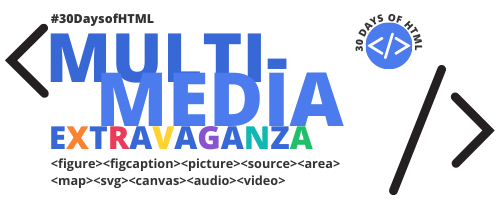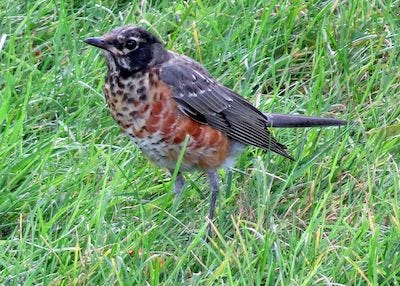#30DaysofHTML Day 26: < figure > and < figcaption >
It's not just for images
Today launches our final unit, the Multimedia Extravaganza! Audio, video, and images of all kinds will be covered in the coming days. Today we start with two elements that we've repeatedly encountered over the past 25 days -- <figure> and <figcaption>.
<figure> and <figcaption> as image and caption
If an image needs a caption, use the
figureandfigcaptionelements.
This is the most common reason that developers use these versatile elements.
<figure>
<img src="img.jpg" alt="Meaningful description of image here, even if there's a caption.">
<figcaption>This is the figure caption that is associated with the above image.</figcaption>
</figure><figcaption> is not a substitute for alt
⛔️ You may think, as many developers do, that if there's a <figcaption> present describing the image, that an alt attribute on the image is not required. Not true, as Scott O'Hara points out:
... an
altis meant to convey the important information an image represents. Afigcaptionshould provide context to relate the figure (image) back to the primary document, or to call out a particular piece of information to pay attention to.
In other words, if we were using this image as a figure:
The alt attribute might be, "Young robin in the grass has a breast and throat with white and black patches, with some orange growing in." A sighted visitor would derive this information from looking at the image, while those without ability to see the image or its details would get it from the alt attribute.
The figure caption, in contrast, might be, "Figure 12: Juvenile American Robin." This description alone is not useful if you are trying to understand what makes a juvenile robin different from an adult robin. However, the caption associates the image with the text, which (hopefully) references Figure 12.
<figcaption> placement and content
✅ If <figcaption> is present, it must be the first child or the last child of the <figure> element.
✅ <figcaption> may contain flow content - basically most of the usual HTML elements. If you want to include paragraphs of information, for example, you could do that.
<figure> without <figcaption>
Why might a developer do this?
<figure>
<img src="img.jpg" alt="Meaningful description of image here.">
</figure>Instead of this?
<img src="img.jpg" alt="Meaningful description of image here."> ✅ If an image is include inside of <figure>, that image may be moved elsewhere on the page without disrupting the meaning of the document.
⚠️ If the image is included by itself, without a <figure> wrapper, then the image is related to the content immediately around it.
<figcaption> pro tip
Remember that what makes a <figure> special is that it can be moved in the document without detriment to the understanding of the document.
⚠️ ⚠️ ⚠️ That means that if you're making reference to "the above image" or "the right side," your <figure> isn't free to move about.
Instead, in your writing, refer to "Figure 1" or similar wording. Then in the <figcaption>, make reference to the same Figure 1. Now readers are able to easily connect your narrative to your figures, regardless of placement.
Multiple images in a <figure>
You may absolutely include multiple images inside of a <figure>, as in this example from WHATWG.
<figure>
<img src="castle1423.jpeg" title="Etching. Anonymous, ca. 1423." alt="The castle has one tower, and a tall wall around it.">
<img src="castle1858.jpeg" title="Oil-based paint on canvas. Maria Towle, 1858." alt="The castle now has two towers and two walls.">
<img src="castle1999.jpeg" title="Film photograph. Peter Jankle, 1999." alt="The castle lies in ruins, the original tower all that remains in one piece.">
<figcaption>The castle through the ages: 1423, 1858, and 1999 respectively.</figcaption>
</figure>Other uses for <figure> and <figcaption>
As we've seen this month, <figure> and <figcaption> may be used in marking up quotes, poems, audio, video, ASCII art, and code snippets, among others.
<figure>
<figcaption>
<cite><a href="https://www.bbcamerica.com/anglophenia/2011/11/salman-rushdie-writes-a-limerick-for-kim-kardashian">"The Marriage of Poor Kim Kardashian,"</a></cite> by Salman Rushdie
</figcaption>
<p>The marriage of poor Kim Kardashian<br>
Was krushed like a kar in a krashian.<br>
Her Kris kried, not fair!<br>
Why kan’t I keep my share?<br>
But Kardashian fell klean outa fashian.</p>
</figure>🖥 See today's CodePen demo and the WHATWG and MDN pages for more examples of <figure> and <figcaption> markup.
🎉📚Get the #30DaysofHTML e-book📚🎉
We are super excited to announce our e-book!
Email is great, and blogs are awesome, but it can be challenging to use them as a reference in the future. We'll be assembling this month's work into an e-book. Would you like a copy?
☕️ If you are financially able to do so, buy us a coffee (or two, or five!). Coffees are $5 each, and the e-book starts at $6 (and will go up from there).
🎉 If you already bought us a coffee, you get an e-book! 😁 🎉
👍 Or spread the word and we'll give you a free e-book! Choose one of these below:
Mention and link to at least one post from #30DaysofHTML in your newsletter by April 30. (If you’ve already done this, you get a free e-book!)
Retweet this e-book announcement, or talk about the e-book on other social media platforms, by April 30!
We will assemble the e-book from these past posts and emails and get that out to you as soon as possible. We anticipate it will be no later than June 30.
<figure> and <figcaption> demo
🖥 View the <figure> and <figcaption> demo on CodePen.
Challenge: <figure> and <figcaption>
👩🏽💻 Try today’s CodePen Challenge about <figure> and <figcaption>. When you’ve completed it, post your answer in our discussion in Substack.
More information and examples
📚 MDN: <figure> and <figcaption>
📚 WHATWG: <figure> and <figcaption>
📚 Scott O’Hara: How do you figure?





